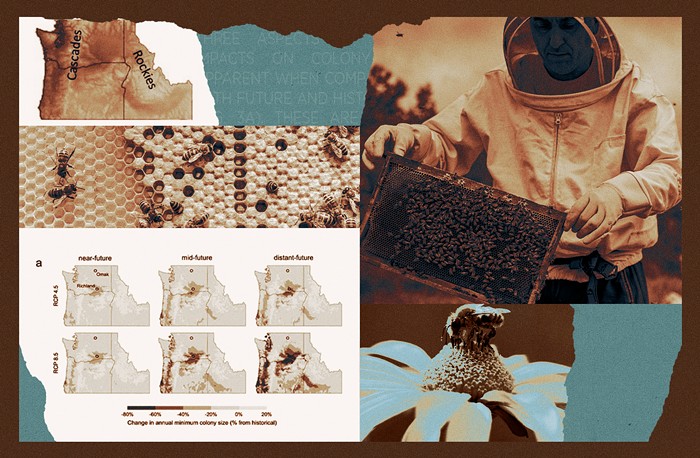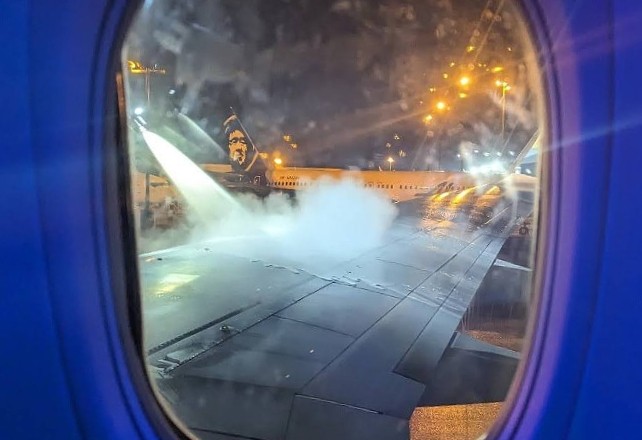
Eli Sanders: It's another smoky day in Seattle, with more warnings against being outside and exercising. Is this going to be our new summer normal?
Hilary Franz: Well, let me start with the big details. We obviously have 11 large fires actively burning on almost 100,000 acres of landscape in Washington State. And so far this year we've responded to 1,142 fires that have burned just under 300,000 acres. We are on a trajectory toward having our most significant wildfire season.
We have been very effective at keeping our fires small, but the reality is between Canada—I don't know if you've seen the map of Canada's significant fires, but it's covering much of their landscape in BC—between that smoke, as well as the significant 27,000 acre fire we have in Twisp, and the Cougar Creek fire at 38,000 acres in Chelan—between all of those things, we're getting a lot of smoke in Seattle.
And a lot of people are asking if this is the new normal.
The reason why this fire season is proving to be so significant is that right now, we have 96 percent of our state in a drought. We have seen, as you know, very little rain since well before May—in fact, May was the driest month we had on record. So a lot of our state that might have had more moisture that would have helped reduce the fires, or made it more difficult for fires to start—that's not occurring.
I would tell you that the biggest challenge we have is that we have 2.7 million acres of forests in Washington State that are dying due to disease, insect infestation, and drought-like conditions. This forest health crisis has been 50-plus years in the making, and we have neglected to address this forest health crisis.
Last year, I announced and completed a 20-year forest health plan, the first of its kind in Washington State, that sets a bold goal of restoring more than 1.25 million acres of forest to health over the next 20 years. Our goal will be treating 70,000 acres a year of forest to help build a more fire-resilient landscape that, when lightning strikes, or when we have a human-caused fire, the forest is actually able to withstand those kinds of hot temperatures and be able to actually put out the fire itself, in a way.

ES: We had a piece on Slog the other day in which a research scientist at the University of Washington said historically, before settlers ever founded this city, the Seattle area would have been smoky in summers. You would have had fires burning out of control and smoke in the Puget Sound lowlands.
This is actually the historical norm, this scientist argued, and previous decades of fire suppression were a historical anomaly. Do you agree with that?
HF: I would tell you that the intense size of our fires, the breadth of the fires, and the length of the fire seasons is new.
Obviously, we've had fire on our landscape throughout our state historically, because much of it was very forested pre-settlers. But, it also didn't have the same hot, dry temperatures and conditions for months on end that we're seeing. And I think the bigger challenge that we really have is that one, we have enabled our forests to grow to be quite clogged with a lot of smaller trees and a lot of forest debris, so that what happens is you have an enormous amount of trees competing for the same sunlight and water—and our water is getting more limited. As they're all competing, you now have a lot of weak trees versus stronger, healthier, more resilient trees.
And what needs to happen, and what our forest health scientists have said, and what our forest health plan is about, is doing a watershed assessment of the treatments that are needed on critical landscapes that are facing the most significant forest health crisis of dead, and dying, and diseased, and infested trees, and being able to remove the dead, dying trees and start to return healthy, strong trees that have enough water and sunlight to grow strong and be more resilient when fire hits.
ES: So you keep saying that a lack of water, which means a lack of rain, is a factor here, and that the exceptionally dry summer that we're having is a factor, too. And your department has said climate change is a factor in the wildfire season we're currently experiencing, which is on track to beat our previous record.
Can you quantify how much of a factor climate change is? Can you give me a percentage or some other sense? I mean, is what we're seeing more due to climate change, or is it more due to forest mismanagement?
HF: I'll tell you, there are three things right now that are leading to this fire season being more significant and more challenging.
Number one, we obviously have a changing climate. We have 96 percent of our state in a drought. We've had 60-plus days in just Western Washington that have not brought rain or any moisture. We had May with the driest month on record. I can go through a number of these records that we're facing, this year alone, on a changing climate. As a result, the forest is drying out much faster and for longer periods of time. So all it takes is one spark, whether it's lightning, or whether it's a human cause.
The second reason we're seeing more significant fires this season is that we have a forest health crisis, as I outlined earlier. Again, all it takes is a simple match, or a simple spark, or a simple lightning strike. And now, instead of maybe a one- or two-acre fire, we have, quickly, the kinds of fires we saw in Grass Valley, where it spread within a couple hours from an acre to 70,000 acres.
The third thing is, 85 percent of our fires this year alone have been caused by humans. We have more human activity that is happening within our forests. We're having more people who are not yet prepared for, or understanding of, our drier, hotter season this year. And so what we've seen is, for example, in April we had a number of brush fires on the western part of our state because people were used to doing brush fires in the early spring and not having—you know, they're burning a number of piles in their backyard, and normally that would stay contained. Unfortunately, by April and May much of that area had already dried out in the western part of the state, so it became a quick, fast-growing fire that people were not prepared for.

ES: When you talk about humans causing 85 percent of these fires—is it all inadvertently? What percentage of that 85 percent is arson or intentional fire-setting? Do you know?
HF: We don't have that number for this year. Obviously, a number of fires have occurred on the landscape and what we do is, we send out our fire investigators to go determine the cause.
We will be able to get that information out to you. I would tell you that while we did see a significant number of arson fires in the Mason County area earlier this year, a lot of the human-caused fires are simply in the context of a brush fire that they thought they could do because the conditions were right, and they didn't realize that the area had already dried out significantly.
We also see things where simple activity—you know, people are driving and there's a chain on the bottom of their truck that creates a spark, that spark jumps over to the side of the road, and because the landscape has dried out so significantly, it spreads through grass and then it hits our drier forest, and then we've got a significant fire.
We have a challenge in our state around exploding targets, where people are out [shooting]—and while they're not legal, that leads to a challenge. And as you also saw, unfortunately, even the plane that was stolen led to a wildfire on our lands that we had to manage.
So there's a whole series of things. But I would tell you, again, the three major causes of why we're seeing more significant wildfires is, one, we are definitely experiencing a changing climate where we're seeing less rainfall in our winters and springs, and our summers are getting hotter and drier. Two, we have a forest health crisis. And three, we have more people living within our forests, and taking on activities within our forests, that sometimes they're not aware are going to lead to fires.
ES: Sometimes you will hear people say, "Oh, a major contributing factor is unhealthy forests. Why don't we just allow more logging? We should log the forests more! That would create conditions in which you'd have fewer fires."
HF: Yeah. Again, our timber production has been going strong in Washington State. Not only on Department of Natural Resource lands, but also on our private lands. I think the important thing for people to focus on here is that we are seeing the importance of what healthy forest management means. And what it means is, getting in and being able to do selective thinning, and healthy management of forests, and bringing prescribed fires back into these forest landscapes—which we have stopped doing.
That's part of what my 20-year forest health plan is. It's bringing forest health science into our forests and ensuring that we are managing them for the long-term health and resiliency of that forest to fire. That does not mean clearcutting and logging. That means healthy management of forests to ensure they can withstand the fires we've seen, they can withstand the drought and the disease that is facing them, and that they can be resilient in the context of long, hot, dry summers.
ES: So to return to my first question: Is this the new normal? Should we expect this next summer and the summer after?
HF: I would tell you that I think we can expect that we're going to see hotter, drier, longer summers. That we're going to see more likely drought conditions (like we've been seeing, frankly, in the last decade). We're still going to be seeing longer, more catastrophic wildfires in the coming years.
My hope and my goal, though, is that as we implement a 20-year forest health plan, as we begin to treat 70,000 acres a year of our forests, as we begin to restore the resiliency of those forests, that we will turn the tide on these catastrophic wildfires. We will start to make a difference.
This problem has been 50 to 100 years in the making. The new approach to bring forest health science in, to make our forests more resilient—and doing it at the scale and the pace I'm talking about—will hopefully mean that in the next five-plus years we're going to turn the tide and we're going to actually reduce the kinds of fires we've seen in 2014, in 2015, and this year.















